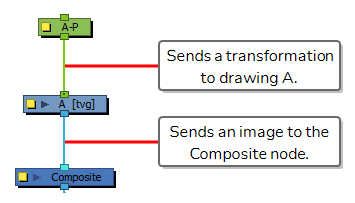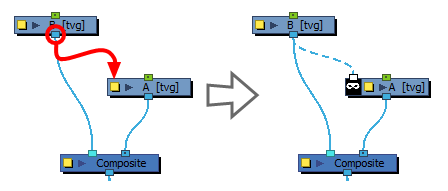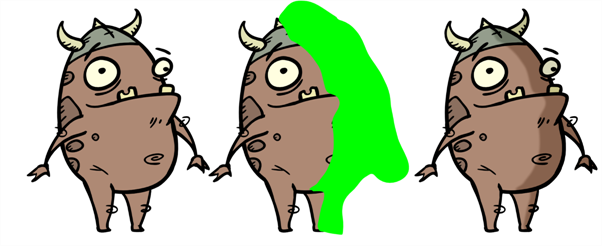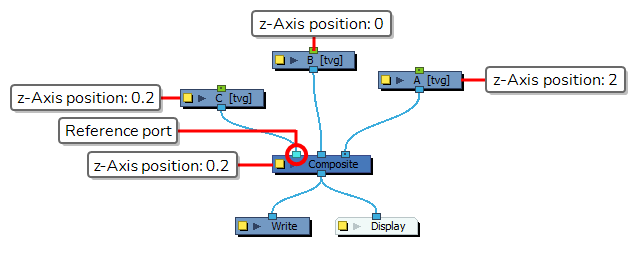T-HFND-010-005
Nodes interact with each other by being connected through their ports. Most nodes have at least one input port and one output port. A node's input ports are on top of the node and can only receive information. A node's output port are at the bottom of the node and can only transfer information.
Port Names
Some nodes contain more than one input or output ports. To have a clue of what each port does, simply click on it to display the name of the port.

Port Colours
Each port has a colour which indicates the kind of information it is meant to send or receive:
- A blue port means the port sends or receive image information. For example, a Drawing node's output port is blue because it outputs an image of its own drawing. A composite's input ports are all blue because a composite receives images and composes them together.
- A green port means the port sends or receive transformation information. For example, Peg, Quadmap and Deformation nodes all have a green output port, because they transform or deform anything connected underneath them. Drawing nodes have a green input port because they receive transformations from such pegs.
Connections between nodes are colour-coded in the same way.

Some ports are flexible in the type of information they send. For example, you can connect a drawing node to another drawing node. When you do this, the cable that links the two nodes is green. This is because the top drawing node's image information is ignored and, instead, the transformations made on this drawing node are applied to the drawing underneath it. In this way, the drawing is acting as a peg.

Some nodes, including Drawing nodes as well as several effect nodes, have what is referred to as a Matte port. A Matte port is used to determine the area to which an effect is applied.
Matte Connections
For some layers, this Matte port is hidden until you attempt to connect an image port to the left extremity of the node. These layers do not require a Matte drawing to work, but can use one if needed.

Other nodes, mostly effects, require a Matte drawing to work. These nodes always have a Matte port visible.

Nodes that have a matte port can be connected to a drawing, which is then referred to as the matte drawing. These nodes use the shape of the matte drawing to determine which area of the image they affect. For example, a Tone node will only apply a tone on the drawing they are connected to in the area where that drawing and the matte drawing mesh.

When an image port is connected to a matte port, its connection is blue, like other image connections, but it is dashed to indicate that it is specifically a matte connection.

Output Z Port
All of the input ports of a Composite node are for laying different drawings or images together into a single image. However, you might notice that the leftmost input port of a Composite node is a lighter shade of blue. This is because this port is used to determine the position of the composited image on the z-Axis. Because each drawing layer has its own position on the z-Axis (which is 0 by default, unless you explicitly move them on the z-Axis), and the Composite node is supposed to make a single flat image out of several drawing layers, it can only have one position on the z-Axis. Hence, by default, it uses the drawing that is connected to its leftmost port, that is, the topmost drawing, as a reference for the position of the image it outputs on the z-Axis.

Pass Through Cables
Composites have several modes, one of which is named Pass Through. A Pass Through composite essentially passes all of the information it receives as is as its output. Hence, its output contains several layers of vector artwork. You can easily tell when a Composite's output contains several layers because its output connection will be a wide cable.
